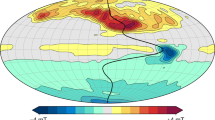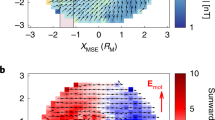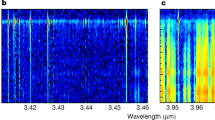Abstract
Determination of the time dependency (secular variation) of a planet’s magnetic field provides a window into understanding the dynamo responsible for generating its field. However, of the six Solar System planets with active dynamos, secular variation has been firmly established only for Earth. Here, we compare magnetic field observations of Jupiter from the Pioneer 10 and 11, Voyager 1 and Ulysses spacecraft (acquired 1973–1992) with a new Juno reference model (JRM09)1. We find a consistent, systematic change in Jupiter’s field over this 45-year time span, which cannot be explained by changes in the magnetospheric field or by changing the assumed rotation rate of Jupiter. Through a simplified forward model, we find that the inferred change in the field is consistent with advection of the field by Jupiter’s zonal winds, projected down to 93–95% of Jupiter’s radius (where the electrical conductivity of the hydrogen envelope becomes sufficient to advect the field). This result demonstrates that zonal wind interactions with Jupiter’s magnetic field are important and lends independent support to atmospheric and gravitational-field determinations of the profile of Jupiter’s deep winds.
This is a preview of subscription content, access via your institution
Access options
Access Nature and 54 other Nature Portfolio journals
Get Nature+, our best-value online-access subscription
$29.99 / 30 days
cancel any time
Subscribe to this journal
Receive 12 digital issues and online access to articles
$119.00 per year
only $9.92 per issue
Buy this article
- Purchase on Springer Link
- Instant access to full article PDF
Prices may be subject to local taxes which are calculated during checkout




Similar content being viewed by others
Data availability
All data and models used in this study are publicly available. The Pioneer 10 and 11, Voyager 1 and Ulysses magnetometer data used in this study are available online on the Planetary Data System. The Jupiter Juno magnetic field model we use is publicly available1. More information regarding the figures and results of this study is available from the corresponding author upon reasonable request.
Change history
06 December 2021
A Correction to this paper has been published: https://doi.org/10.1038/s41550-021-01554-2
References
Connerney, J. E. P. et al. A new model of Jupiter’s magnetic field from Juno’s first nine orbits. Geophys. Res. Lett. 45, 2590–2596 (2018).
Connerney, J. E. P. & Acuña, M. H. Jovimagnetic secular variation. Nature 297, 313–315 (1982).
Connerney, J. E. P., Acuña, M. H., Ness, N. F. & Satoh, T. New models of Jupiter’s magnetic field constrained by the Io flux tube footprint. J. Geophys. Res. 103, 11929–11939 (1998).
Yu, Z. J., Leinweber, H. K. & Russell, C. T. Galileo constraints on the secular variation of the Jovian magnetic field. J. Geophys. Res. 115, E03002 (2010).
Ridley, V. A. & Holme, R. Modeling the Jovian magnetic field and its secular variation using all available magnetic field observations. J. Geophys. Res. Planets 121, 309–337 (2016).
Connerney, J. E. P., Acuña, M. H. & Ness, N. F. Modeling the Jovian current sheet and inner magnetosphere. J. Geophys. Res. 86, 8370–8384 (1981).
Jones, C. A. A dynamo model of Jupiter’s magnetic field. Icarus 241, 148–159 (2014).
Dietrich, W. & Jones, C. A. Anelastic spherical dynamos with radially variable electrical conductivity. Icarus 305, 15–32 (2018).
Riddle, A. C. & Warwick, J. W. Redefinition of the System III longitude. Icarus 27, 457–459 (1976).
Higgins, C. A., Carr, T. D., Reyes, F., Greenman, W. B. & Lebo, G. R. A redefinition of Jupiter’s rotation period. J. Geophys. Res. 102, 22033–22041 (1997).
Russell, C. T., Yu, Z. J. & Kivelson, M. G. The rotation period of Jupiter. Geophys. Res. Lett. 28, 1911–1912 (2001).
Iess, L. et al. Measurement of Jupiter’s asymmetric gravity field. Nature 555, 220–222 (2018).
Porco, C. C. et al. Cassini imaging of Jupiter’s atmosphere, satellites, and rings. Science 299, 1541–1547 (2003).
Guillot, T. et al. A suppression of differential rotation in Jupiter’s deep interior. Nature 555, 227–230 (2018).
Kaspi, Y. et al. Jupiter’s atmospheric jet streams extend thousands of kilometres deep. Nature 555, 223–226 (2018).
Nellis, W. J., Mitchell, A. C., McCandless, P. C., Ersine, D. J. & Weir, S. T. Electronic energy gap of molecular hydrogen from electrical conductivity measurements at high shock pressures. Phys. Rev. Lett. 68, 2937–2940 (1992).
Weir, S. T., Mitchell, A. C. & Nellis, W. J. Metallization of fluid molecular hydrogen at 140 GPa (1.4 Mbar). Phys. Rev. Lett. 76, 1860–1863 (1996).
French, M. et al. Ab initio simulations for material properties along the Jupiter adiabat. Astrophys. J. Suppl. 202, 5 (2012).
Celliers, P. M. et al. Insulator–metal transition in dense deuterium. Science 361, 677–682 (2018).
Cao, H. & Stevenson, D. J. Zonal flow magnetic field interaction in the semi-conducting region of giant planets. Icarus 296, 59–72 (2017).
Liu, J., Goldreich, P. M. & Stevenson, D. J. Constraints on deep-seated zonal winds inside Jupiter and Saturn. Icarus 196, 653–664 (2008).
Moore, K. M., Bloxham, J., Connerney, J. E. P., Jorgensen, J. L. & Merayo, J. M. The analysis of initial Juno magnetometer data using a sparse magnetic field representation. Geophys. Res. Lett. 44, 4687–4693 (2017).
Moore, K. M. et al. A complex Jovian dynamo from the hemispheric dichotomy of Jupiter’s field. Nature 561, 76–78 (2018).
ConnerneyJ. E. P.., Acuña, M. H. & Ness, N. F. The Z3 model of Saturn’s magnetic field and the Pioneer 11 vector helium magnetometer observations. Geophys. Res. 89, 7541–7544 (1984).
Smith, E. J. et al. The planetary magnetic field and magnetosphere of Jupiter: Pioneer 10. J. Geophys. Res. 79, 3501–3513 (1974).
Ness, N. F. et al. Magnetic field studies at Jupiter by Voyager 1: preliminary results. Science 204, 982–987 (1979).
Behannon, K. W., Acuña, M. H., Burlaga, L. F., Lepping, R. P. & Ness, N. F. Magnetic field experiment for Voyagers 1 and 2. Space Sci. Rev. 21, 235–257 (1997).
Balogh, A. et al. The magnetic field investigation on the Ulysses mission: instrumentation and preliminary scientific results. Astron. Astrophys. Suppl. Ser. 92, 221–236 (1992).
Edwards, T. M., Bunce, E. J. & Cowley, S. W. H. A note on the vector potential of Connerney et al.’s model of the equatorial current sheet in Jupiter’s magnetosphere. Planet. Space Sci. 49, 1115–1123 (2001).
Starchenko, S. V. & Jones, C. A. Typical velocities and magnetic field strengths in planetary interiors. Icarus 157, 426–435 (2002).
Kong, D., Zhang, K., Schubert, G. & Anderson, J. D. Origin of Jupiter’s cloud-level zonal winds remains a puzzle even after Juno. Proc. Natl Acad. Sci. USA 115, 8499–8504 (2018).
Acknowledgements
All authors acknowledge support from the NASA Juno Mission. K.M.M. is supported by the Department of Defense (DoD) through the National Defense Science and Engineering Graduate Fellowship (NDSEG) programme, and the Harvard Graduate School of Arts and Sciences (GSAS) Merit Fellowship. We thank Richard Holme for helpful comments.
Author information
Authors and Affiliations
Contributions
K.M.M, H.C. and J.B. designed the study and wrote the manuscript. K.M.M. performed the data analysis, while H.C. performed the zonal wind calculations. All authors contributed to discussions, as well as editing and revising the manuscript. J.E.P.C. is the principal investigator of the Juno magnetometer investigation, and S.J.B. is the principal investigator of the Juno Mission.
Corresponding author
Ethics declarations
Competing interests
The authors declare no competing interests.
Additional information
Journal peer review information: Nature Astronomy thanks Richard Holme and Chris Jones for their contribution to the peer review of this work.
Publisher’s note: Springer Nature remains neutral with regard to jurisdictional claims in published maps and institutional affiliations.
Supplementary information
Supplementary Information
Supplementary Figs. 1–6, Supplementary Tables 1 and 2, captions of Supplementary Datasets 1–3, Supplementary references
Supplementary Dataset 1
Harmonic coefficients for the ZWA model using winds projected at 0.95 RJ
Supplementary Dataset 2
Harmonic coefficients for the ZWA model using winds projected at 0.94 RJ
Supplementary Dataset 3
Harmonic coefficients for the ZWA model using winds projected at 0.93 RJ
Rights and permissions
About this article
Cite this article
Moore, K.M., Cao, H., Bloxham, J. et al. Time variation of Jupiter’s internal magnetic field consistent with zonal wind advection. Nat Astron 3, 730–735 (2019). https://doi.org/10.1038/s41550-019-0772-5
Received:
Accepted:
Published:
Issue Date:
DOI: https://doi.org/10.1038/s41550-019-0772-5
This article is cited by
-
A rapidly time-varying equatorial jet in Jupiter’s deep interior
Nature (2024)
-
Observational evidence for cylindrically oriented zonal flows on Jupiter
Nature Astronomy (2023)
-
Jupiter’s cloud-level variability triggered by torsional oscillations in the interior
Nature Astronomy (2023)
-
Waves in planetary dynamos
Reviews of Modern Plasma Physics (2022)
-
The in-situ exploration of Jupiter’s radiation belts
Experimental Astronomy (2022)



